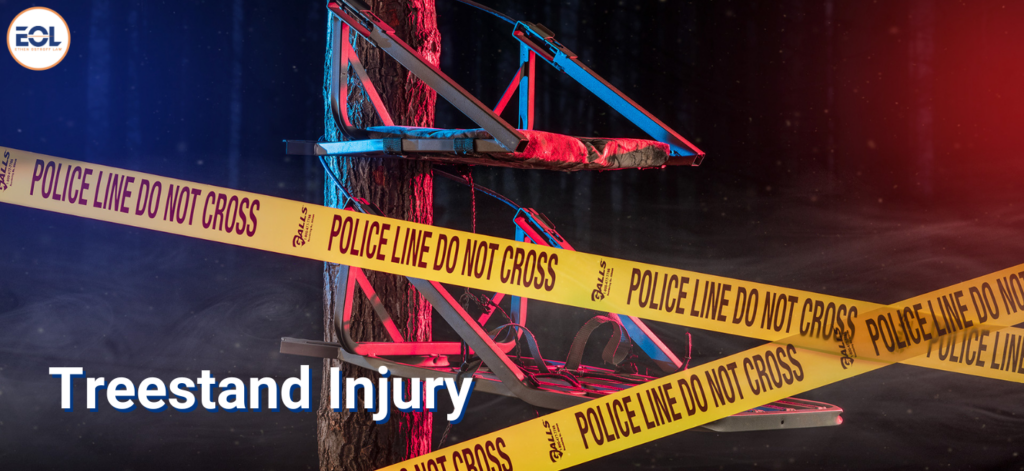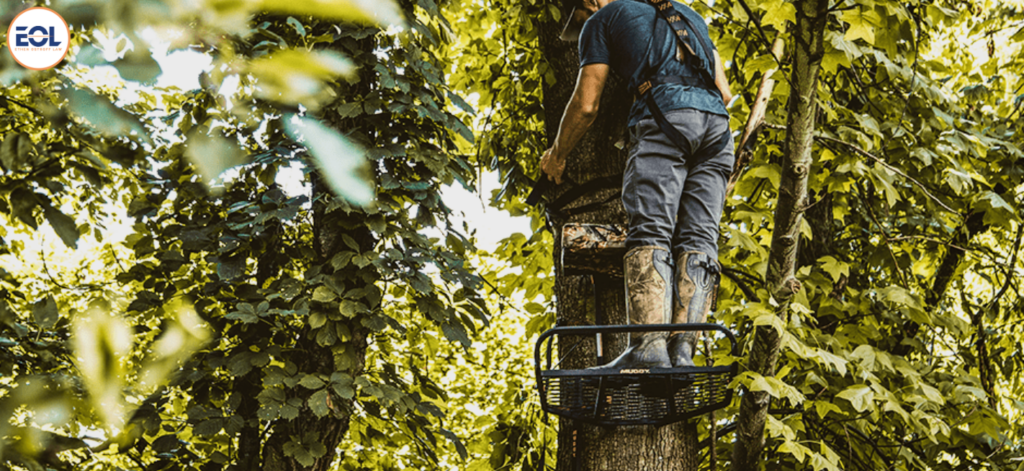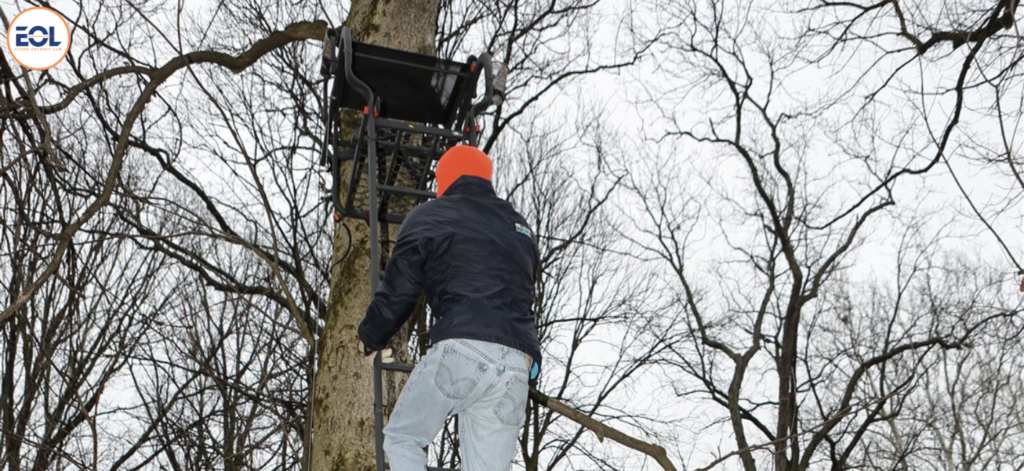Treestand Injury Lawsuit | Compensation for Defective Treestand Accident
Experience the tranquility of the woods from a tree stand, perched high amidst the branches, waiting for that perfect shot. But what happens when this idyllic scenario turns into a nightmare? Accidents caused by defective tree stands can shatter the peace and lead to devastating injuries. If you or someone you care about has suffered due to a malfunctioning tree stand, you deserve justice and compensation. Explore your legal options with a treestand injury lawsuit to hold responsible parties accountable. Secure the support you need to move forward with Ethen Ostroff Law.
Tree Stand: What Is It?
A tree stand is a raised platform hunters use, attached to trees, to improve visibility and shooting angles while pursuing game animals like deer, turkey, or elk. Available in various designs such as ladder stands, climbing stands, hang-on stands, and tower stands, they are typically made of durable materials like steel or aluminum. Many tree stands include features like seats, safety harnesses, and other accessories to enhance comfort and ensure hunters’ safety.
Types of Tree Stands
Hunters have various tree stand options for elevated hunting positions:
- Box Blind Tree Stands: Enclosed structures on elevated platforms for shelter and concealment.
- Climbing Tree Stands: Portable stands allowing climbers to ascend trees without extra gear.
- Hang-On Tree Stands: Lightweight platforms secured to trees, versatile and easy to relocate.
- Ladder Tree Stands: Stands with stable access provided by a ladder or steps.
- Tower Tree Stands: Platforms supported by sturdy legs or posts, ideal for open fields.
- Tripod Tree Stands: Freestanding platforms mounted on a tripod base, offering stability.
Each type has unique advantages and drawbacks based on factors like portability, comfort, and hunting environment.

Popular Brands of Tree Stands for American Hunters
Hunters in the US have a variety of popular tree stand brands to choose from:
- Lone Wolf Treestands: Known for sleek, minimalist designs and highly portable climbing and hang-on stands.
- Millennium Treestands: Specializing in comfortable, spacious ladder and hang-on stands with ergonomic seats for all-day comfort.
- Muddy Outdoors: Offering rugged ladder, climbing, and hang-on stands with practical features tailored to different hunting environments.
- Ol’ Man Treestands: Despite safety concerns, favored for lightweight, comfortable climbing and hang-on stands.
- Summit Treestands: Renowned for innovative, lightweight designs with climbing, hang-on, and ladder stands known for durability and user-friendliness.
- X-Stand Treestands: Known for feature-rich designs emphasizing stability, comfort, and easy setup in the field with climbing, hang-on, and ladder stands.
Statistics on Tree Stand Accidents and Injuries
Tree stand accidents and injuries pose a significant concern within the US hunting community. A 2017 Multi-State Analysis revealed that 31% of injuries occur with lock-on tree stands, followed by 25% with climber types. Shockingly, 95% of tree stand injuries result from hunters not wearing full-body harnesses, emphasizing the critical importance of safety gear. Most injuries happen during climbing in and out of the stands, with an estimated 6,000 hunters suffering falls annually in the US. The majority of these falls occur during the ascent or descent from the tree stand.
Common Causes of Tree Stand Accidents
Tree stand accidents can stem from several factors, including equipment failure, user error, and environmental conditions. Here are some common causes:
- Adverse weather conditions.
- Climbing too quickly or using unsafe climbing methods.
- Failure to use safety equipment properly or at all, such as harnesses or lifelines.
- Improper installation, equipment failure, and inadequate maintenance.
- Lack of training or experience with proper safety protocols.
- Overloading tree stands beyond their weight limit.
- Slippery surfaces on tree stands, steps, or ladder rungs.
- Wildlife encounters that startle hunters.
Tree Stand Recalls in the US
Here is notable tree stand recalls in the US:
- API Outdoors Treestands Recall (2015): Certain models of climbing tree stands were recalled due to a fall hazard from cables separating from the frame. Affected models included the API Outdoors Baby Grand Lite and Baby Grand Treestands.
- Big Game Treestands Recall (2016): A recall was issued for certain climbing tree stands due to a fall hazard from cables disengaging from the tree. Affected models included the Big Game Hunter HD 1.5 Treestand and Big Game Hunter HD 1.0 Treestand.
- Ol’ Man Treestands: While facing controversy and legal action over safety concerns, specific recalls may vary. However, the company has dealt with litigation related to alleged defects and injuries from their products.
- Summit Treestands Recall (2015): Certain models of climbing treestands were recalled due to a fall hazard caused by cables separating from the frame. Affected models included the Summit Explorer SD Closed Front Climbing Treestand and Summit Mini Viper SD Closed Front Climbing Treestand.
- X-Stand Treestands Recall (2020): Certain models of climbing tree stands were recalled due to a fall hazard from cables separating from the frame. Affected models included the X-Stand Jayhawk and Apache Climbing Treestands.
These recalls highlight the importance of ensuring the safety of tree stand products to prevent accidents and injuries while hunting.
Risks Posed by Defective Tree Stands
Defective tree stands pose grave risks to hunters, potentially resulting in accidents, injuries, and fatalities. Here are the dangers associated with them:
- Defective stands may have unstable platforms.
- Defective stands may lack essential safety features.
- Faulty tree stands can worsen dangers from factors like high winds or uneven terrain.
- Flaws like welding defects or material weaknesses can compromise the structural integrity of the stand.
- Malfunctioning harnesses can fail to secure hunters properly.
- Manufacturers may be held responsible for injuries caused by defective stands, opening the door for legal action by affected hunters.
- Manufacturers may issue recalls for defective stands, but hunters who are unaware of or ignore these recalls may continue to use unsafe products.
- Poorly designed tree stands may have flaws like inadequate weight distribution or stability.
- Weak structural components can lead to collapse or failure.

Common Injuries from Defective Tree Stands
Defective tree stands can cause a range of injuries for hunters, from minor to severe. Here are common injuries resulting from accidents involving them:
- Amputations of limbs or extremities.
- Emotional trauma and psychological distress.
- Fatalities.
- Fractures and broken bones.
- Head and brain injuries.
- Internal injuries.
- Soft tissue injuries.
- Spinal cord injuries.
Safety Guidelines for Using a Tree Stand
Ensuring safety while using tree stands is crucial for every hunter. Here are essential safety guidelines to minimize the risk of accidents and injuries:
- Always maintain three points of contact when climbing in or out of the tree stand.
- Avoid alcohol, drugs, or medications that may impair judgment or coordination while hunting.
- Avoid using tree stands in adverse weather conditions to prevent accidents on slippery surfaces.
- Carry emergency supplies like a first aid kit, whistle, and flashlight, and know self-rescue techniques.
- Follow ethical hunting practices, respect regulations, and ensure firearm safety.
- Invest in reliable tree stands with safety features from reputable manufacturers.
- Safely fasten firearms and equipment before ascending or descending from the tree stand.
- Share your hunting plans and emergency contact information with someone and consider using communication devices.
- Thoroughly inspect your tree stand for damage or defects before each use.
- Understand and follow the manufacturer’s instructions for assembly, installation, and usage of your tree stand.
- Wear a securely attached full-body harness to the tree and always stand to prevent falls and serious injuries.
Returning a Recalled Tree Stand
Returning a recalled tree stand typically involves these steps:
- Identify the Recalled Product: Confirm that the tree stand matches the recalled product by checking its name, model number, and other identifying features.
- Contact the Manufacturer or Distributor: Reach out to the manufacturer or distributor via their dedicated recall website, hotline, or email to start the recall process.
- Provide Proof of Purchase: Some manufacturers may require proof of purchase, like a receipt or invoice, to validate the product’s eligibility for recall.
- Follow Instructions: Adhere to the manufacturer’s instructions for returning the recalled product. This may entail shipping it back or dropping it off at a designated location.
- Receive Replacement or Refund: Once the recalled product is returned, the manufacturer will provide a replacement or refund according to the terms outlined in the recall notice.
Hunters can ensure a smooth and safe return process for their recalled tree stand by following these steps diligently.
Reporting a Fall Injury Caused by a Recalled Tree Stand
Reporting a fall injury caused by a recalled tree stand involves these steps:
- Seek immediate medical attention for any injuries sustained from the fall.
- Keep detailed records of the incident, including date, time, location, and how the fall occurred.
- Take photos of the tree stand, injuries, and surroundings.
- Inform the manufacturer of the recalled tree stand about the fall injury, providing comprehensive details.
- Report the fall injury to relevant consumer protection agencies like the Consumer Product Safety Commission.
- Consider consulting a treestand injury attorney if you have been injured due to a recalled tree stand to understand your legal rights and pursue compensation.
Crucial Details for Recalled Tree Stands
When reporting a fall injury due to a recalled tree stand, provide:
- Incident Description: Date, time, location, circumstances, and any preventive measures.
- Injury Description: Type and severity of injuries, medical provider’s details if treated.
- Personal Details: Your name, contact info, and witnesses’ contact if available.
- Product Info: Manufacturer, model number, and photos if possible.
- Product Usage History: Purchase date, location, and frequency of use.
- Recall Details: Recall date and any actions taken in response.

Legal Options for Victims of Defective Tree Stands
Victims of defective tree stands have legal avenues to seek compensation for their injuries and losses. Here are potential options for those harmed by faulty tree stands:
- Breach of Warranty Claims: Pursue claims if the tree stands were sold with warranties regarding safety or fitness for use, asserting failure to meet warranty terms.
- Class Action Lawsuits: Join forces in a class action lawsuit consolidating similar claims into a single legal action for increased efficiency.
- Consultation with Legal Experts: Seek guidance from a tree stand injury lawyer specializing in product liability, evaluating the case, and providing advice.
- Negligence Claims: File claims against parties whose actions contributed to the defectiveness of the tree stands, alleging inadequate quality control or failure to warn consumers.
- Product Liability Lawsuits: Pursue a treestand recall lawsuit against manufacturers, distributors, or retailers for defective design, manufacturing, or marketing causing injuries.
- Recall Compliance Claims: Take legal action if a manufacturer or distributor failed to issue a timely recall or address known safety issues, holding them accountable.
- Wrongful Death Lawsuits: Surviving family members can seek compensation for loss of companionship and financial support if a defective tree stand caused a loved one’s death.
Filing a Treestand Injury Lawsuit
Filing a treestand injury lawsuit involves critical steps to protect your rights and seek compensation:
- Seek Medical Attention: Prioritize your health by getting prompt medical treatment for your injuries, ensuring proper documentation.
- Document the Incident: Gather evidence like photos, witness statements, and medical records to support your case.
- Consult with a Tree Stand Injury Lawyer: Contact a treestand injury attorney specializing in product liability to assess your case and guide you through the legal process.
- Investigation and Discovery: Your tree stand injury lawyer will investigate the accident’s cause, gather evidence, and obtain expert opinions.
- Drafting and Filing the Complaint: Prepare a formal legal complaint outlining the details of the accident and file it with the court.
- Discovery Process: Exchange information and evidence with the opposing party through written interrogatories and depositions.
- Settlement Negotiations: Work with your tree stand injury lawyer to negotiate a fair settlement.
- Trial: If no settlement is reached, proceed to trial, where evidence is presented to a judge and/or jury.
- Judgment and Appeal: Await the court’s decision and be prepared for a possible appeal by the defendant.
- Collecting Compensation: Your treestand injury attorney will help collect the compensation owed to you through legal enforcement or negotiation.
Liable Parties in Defective Treestand injury Lawsuit
In defective tree stand lawsuits, liable parties include:
- Hunting clubs for negligence.
- Individuals for accidents caused by negligence.
- Manufacturers for design or manufacturing defects.
- Property owners for hazardous conditions.
- Wholesalers, distributors, and retail stores for placing defective products.
Victims should consult a tree stand injury attorney for legal guidance and compensation.
Compensation for Defective Treestand Injuries
Victims of defective treestand injuries may seek various types of compensation, including:
- Disfigurement and scarring.
- Emotional distress.
- Loss of enjoyment of life.
- Lost income.
- Medical expenses.
- Pain and suffering.
- Property damage.
- Punitive damages.
The amount of compensation varies based on factors like injury severity and evidence strength. Consulting a tree stand injury lawyer can help victims pursue fair compensation.
Ethen Ostroff Law | Tree Stand Injury Lawyer
At Ethen Ostroff Law, we understand the serenity of the great outdoors can turn to adversity when treestand injuries occur. If you have been hurt due to a defective treestand, you do not have to navigate the legal wilderness alone. Our team is here to guide you through the complexities of defective tree stand lawsuits. Contact us today for a free consultation.
Related Questions on Treestand Injury Lawsuit
What is the lawsuit against Ol' Man treestand?
The lawsuit against Ol‘ Man treestand involves a wrongful death claim filed by a hunter’s widow after he fell from an Ol‘ Man Tree Stand and died. The treestand injury lawsuit targeted TSR Inc., the manufacturer, seeking damages for funeral expenses, lost wages, and other losses. In 2009, an Indiana jury awarded the widow $157 million in damages. Allegations included claims of a defective treestand and insufficient warnings about its risks, underscoring the importance of safety in hunting equipment.
What are the injuries to tree stands?
Tree stand injuries are a big worry for hunters, causing serious harm like spinal fractures, strains, and sprains. Falls from heights ranging from 6 to 30 feet can lead to severe injuries, even from shorter falls of 6-8 feet. Common causes include equipment malfunctions, poor labeling, and damage from the environment.
Which tree stand is considered unsafe?
Tree stands become unsafe if they are damaged, incorrectly installed, or not used as per the manufacturer’s instructions. Those with ladder sections relying solely on straps or chains for attachment are often deemed less secure compared to stands with better attachment methods like ratchet straps or cables. Homemade or improvised tree stands can also be highly unsafe due to the absence of proper engineering and testing.
What is a common cause of accidental falls from a tree stand?
Accidental falls from tree stands often occur due to improper or lack of use of safety harnesses or safety lines. Falls commonly happen during climbing into or out of the tree stand, adjusting equipment, or changing positions. Inadequate maintenance of the tree stand, such as rusted or weakened components, can also lead to failure and falls. Other factors include slipping on wet surfaces or losing balance due to sudden movements.


